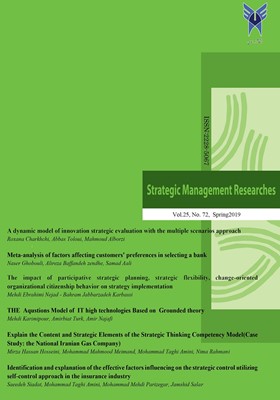-
-
List of Articles
-
Open Access Article
1 - Designing a Dynamic Model for Strategic Evaluation of Innovation with a Multiple Scenario Approach
Roxaneh Charkhchi abas toloi mahmood alborzi -
Open Access Article
2 - Meta-Analysis o Factors Affecting Customers' Preferences in Selecting a Bank
naser Ghabouli ALIREZA Bafandeh Zendeh Samad Aali -
Open Access Article
3 - The Impact of Participative Strategic Planning, Strategic Flexibility and Change-Oriented Organizational Citizenship Behavior on Strategy Implementation
Mehdi Ebrahimi Nejad bahram jabarzadeh carbasi -
Open Access Article
4 - The Acquisition Model of Advanced IT Technology based on the Grounded Theory
mehdi karimipour Amir bayat tork Amir Najafi -
Open Access Article
5 - Designing and Explaining the Content and Strategic Elements of the Strategic Thinking Competency Model (Case Study: the National Iranian Gas Company)
mirzahasan hosseini Mohammad Mahmoodi Meymand Mohammad Taghi Amini nima rahmani -
Open Access Article
6 - Identification and Explanation of the Factors Affecting Strategic Control with a Self-Control Approach in the Insurance Industry
saeideh sayadat mohamad taghi amini mohammad mehdi parhizghar jamshid salar
-
The rights to this website are owned by the Raimag Press Management System.
Copyright © 2021-2025







